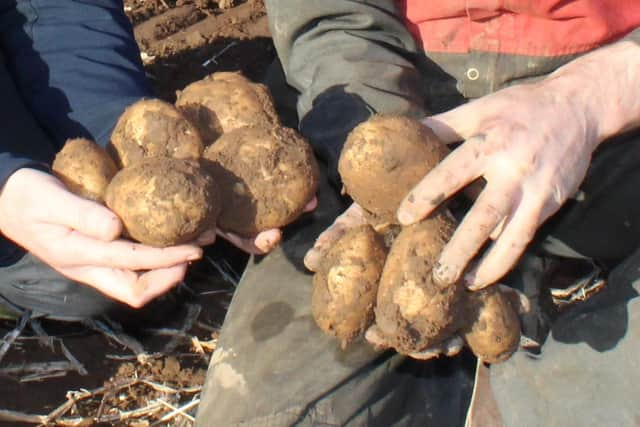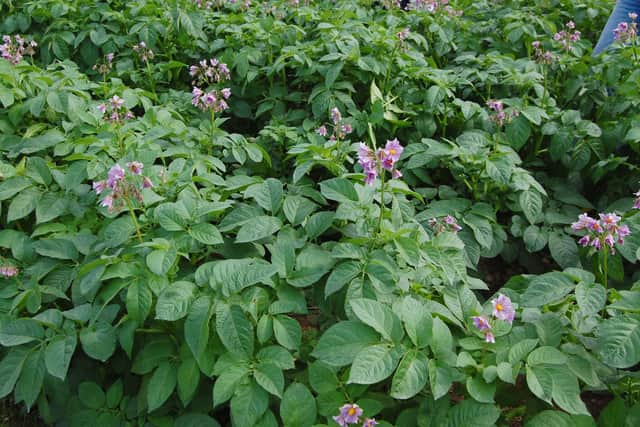New blight challenges to confront the potato sector in 2024
and live on Freeview channel 276
It’s a future based on the use of two active fungicide molecules in combination – and each at full rate – each time a crop is sprayed for blight.
Driving all of this is the confirmation that blight populations are fast developing resistance to the fungicide chemistries currently available at an ever increasing rate.
Advertisement
Advertisement
More specifically, last autumn was marked by the confirmation that the EU43 variant of the blight fungus (Phytophthora infestans) had been identified in Irish potato crop samples.


This is the genotype that had previously caused tremendous to potato crops in both Denmark and the Netherlands, as a direct result of its resistance to the carboxylic acid amide (CAA) group of fungicides.
Despite the fact that only one EU43 infected sample was identified, Teagasc and all other stakeholder groups within the potato sector are now working on the basis that the genotype is on the island of Ireland and poses a major threat to potato crops that are grown across the island of Ireland this this year.
The envisaged response at grower level will be the ramping up of all blight spray formulations, both in terms of their scope and complexity.
Advertisement
Advertisement
By taking this approach, Teagasc potato specialists believe that the threat of EU43 can be controlled.


However, the steps required to make this happen at farm level will, probably, double the cost of the associated blight prevention programmes that will be required.
Teagasc hosted a specific blight workshop for representative all relevant potato stakeholders groups earlier this week.
The event was the first in a series of events that will be held over the coming weeks with a clear focus on the threat posed by the EU43 genotype.
Advertisement
Advertisement
This specific blight variant was first identified in Denmark back in 2018.
However, it was the carnage caused by the new genotype within Dutch potato populations last year that has raised the alarm bells regarding its potency and the potential damage it can cause to the potato industry here in Northern Ireland, if suitable preventative measures are not taken.
Attendees at the workshop were told it normally takes two years after new blight genotypes have been identified in the UK or mainland Europe to get to Ireland.
Imported seed potatoes constitute a key disease vector in this regard.
The Dutch experience
Advertisement
Advertisement
Dutch plant pathologist, Dr Geert Kessel, from Wageningen University addressed the workshop.
He confirmed that the potato blight fungus is now completing its life cycle in a much shorter period of time than would have previously been the case.
Dr Kessel added: “Twenty years ago, it would have taken the fungus five to ten days to complete its various growth and reproductive phases.
“Today we are talking two to five days.
“The potential for Phytophthora infestans to mutate is immense. One hectare of infected potatoes can produce 4x1012 sporangia. These are containers within which spores can form.
Advertisement
Advertisement
“Research has confirmed that 40,000 of these sporangia will contain mutated genetic material.”
According to Kessel, the Dutch potato industry totally underestimated the potential impact of the EU43 blight genotype last year.
This was despite the fact that previous experience in Denmark has confirmed the significant increase of its prevalence within that country’s blight populations.
In 2018 EU43 accounted for just 2% of the blight variants identified in Denmark.
By 2022 that figure had risen to 43%.
Weather factors in 2023
Advertisement
Advertisement
Geert Kessel again: “Last year’s very challenging weather conditions also combined to enhance the impact of the EU43 genotype.
“Main crop potatoes were planted out in late May.
“While daytime conditions were dry and quite warm at that stage, crops experienced quite a dramatic drop in temperatures during the night time hours.
“This facilitated early blight infections.
“But as the season progressed the heavy rains arrived, impacting on potato crop performance right through to harvest.”
According to Kessel, the fundamental mistake made by Dutch potato growers last year was to use blight control applications that focused on the use of a single fungicide molecule.
Advertisement
Advertisement
He explained: “This gave the genotype an opportunity to develop almost unhindered.
“We now know from the experience gained in Denmark that the most effective way of countering EU43 is to use a combination of fungicide molecules at full rate throughout the growing season.”
According to Kessel there is now evidence pointing to EU43’s resistance to other blight chemistries.
“This is extremely worrying as is the identification of another blight genotype: EU46,” he added.
ADAS trials
Advertisement
Advertisement
ADAS plant pathologist, Dr Faye Ritchie, also addressed the blight workshop.
She highlighted the growing threat of new blight genotypes and the steps growers can take to prevent their impact on potato crops, making use of the existing blight chemistries.
According to the ADAS representative this will entail widest use of the various blight chemistries – in approved combinations - throughout the growing season.
“We now know that using the same chemistry throughout the lifespan of a crop is the most effective way of encouraging resistance within an ambient blight population,” Dr Faye Ritchie stated.
Teagasc recommendations 2024
Advertisement
Advertisement
Teagasc’s Dr Steven Kildea told the workshop that an holistic approach must be taken regarding the management of fungicide resistant blight genotypes.
His research work focuses on the development of sustainable disease control strategies for arable and potato crops.
Kildea commented: “The further development of blight resistant potato varieties will be part of this process moving forward.
“Growers will also be required to implement crop management strategies that minimise the potential for blight variants to become established in crops.
Advertisement
Advertisement
“This will include the use of seed that is pathogen-free and the effective management of potato volunteers.”
He added: “There is also a need to develop fungicide spray strategies that do two things: prevent blight becoming established within crops while, at the same time, controlling the exposure of existing fungicide chemistries to new blight variants.”
Kildea stressed the fast evolving nature of blight resistance.
He further explained: “Using combinations of different blight control chemistries throughout the growing season is the future for potato growers.
Advertisement
Advertisement
“But this blight management approach will entail a significantly increased cost, where the future procurement of blight sprays is concerned.”
Kildea discussed a possible blight prevention spray programme that might be considered by Irish potato growers this year, based on a projected 15-phase cycle.
According to Kildea, the work carried out to date has identified 14 of the 15 envisaged spray cycles.
He added: “This is a very complex issue.
“But work will continue to identify what is the most feasible spray mix to end the blight spraying season on.”
Advertisement
Advertisement
The Teagasc representative concluded: “The threat of fungicide-resistant blight genotypes will rise in significance during the period ahead.
“And the potato industry must respond in a multi faceted manner. However, the short term imported seed from countries, such as the Netherlands, will heighten the challenge posed by the EU43 blight genotype in 2024.”
Controlling potato blight
Humidity in the range 88 to 90%, combined with the odd shower, constitute the perfect weather conditions for the spread of potato blight.
According to Steven KIldea the inoculums causing blight can come from three sources: seed, ground keepers and old potato dumps.
He further explained: “Blight over winters in the tuber.
“Certified seed represents a very low infection risk.
Advertisement
Advertisement
“Dumps are tubers that have gone over the grader the previous years and have been kicked out.
“So a dump could, potentially, contain tubers that have blight. Volunteers that were not lifted from the field could also constitute a significant source of blight infection.”
By this time of the year, all potato crops will have reached the stable canopy stage of development.
Kildea confirmed that blight preventative products used now must have some form of translaminar activity.
“They are going to move through the leaf,” he said.
Advertisement
Advertisement
“Disease risk relates to two issues: the presence of the inoculums and conducive weather conditions.
“If inoculums are present early in the season, then crops of potatoes will be predisposed to blight from the get go.
“The vast majority of the potato varieties that we grow in Ireland are susceptible to blight.”
Kildea confirmed that managing blight risk is crucially important.
Advertisement
Advertisement
“This includes the effective management of old potato dumps,” he stressed.
“Untreated potatoes growing in gardens could represent a source of infection for commercial growers.
But, according to Kildea, weather is the other key factor that must be taken account of, where blight pressure is concerned.
He concluded: “Teagasc has worked with Met Éireann to tweak blight forecasts.
Advertisement
Advertisement
“This has been made possible by the availability of relevant data that has been generated over the last number of years.
“We can now predict the possible impact of blight much better. We can now more accurately predict the risks associated with a potato blight infection.
“These improved forecasts do not confirm if inoculum is close by. However, they do confirm that a combination of high weather pressure and the presence of inoculum will combine to generate actual blight in potato crops within a period of 7 to 10 days.”
The days of growing cheap potatoes are over
So much for the background: the overwhelming reality now confronting growers in Northern Ireland is that potatoes are about to become an extremely expensive crop to grow.
In truth, this has always been the case.
Advertisement
Advertisement
However, the new fungicide protocols required to keep potato crops blight free are about to increase the overall cost of producing spuds by a multiplier effect of significant magnitude.
Given this more than significant background, it seems obvious that consumers should be made fully aware of this reality.
And the clock is ticking.
This is a challenge that now confronts every stakeholder group impacting on the potato sector: starting with the farming organisations
The supermarkets must not be given an opportunity to conveniently overlook the real threat posed by blight to the Irish potato sector.
Advertisement
Advertisement
Indeed, they must publicly be challenged to come forward with their own perspectives on the matter and relate how they plan to work with farmers in helping to deal with this very significant problem.
And all of this must be done now.
By taking this approach, potato growers will gain some confidence for the season ahead,
The coming weeks will see 2024 main crop potatoes planted out.
And, according to Teagasc, the job of applying the new spray regimes kicks-in from the outset.
Advertisement
Advertisement
Hoping for a dry and warm growing season isn’t an option for growers.
They have no alternative but to plan for the worst and hope for the best.
It’s an approach to potato growing that comes with a more than hefty cost ticket.